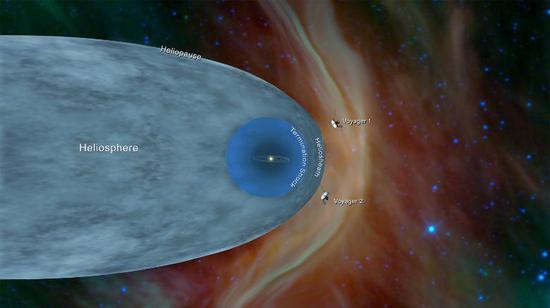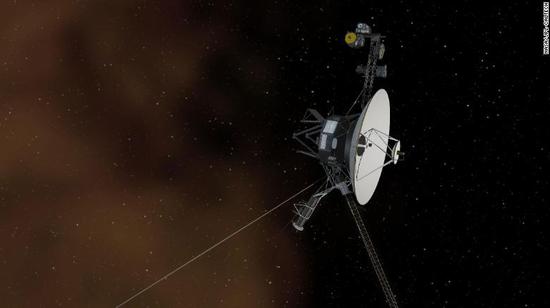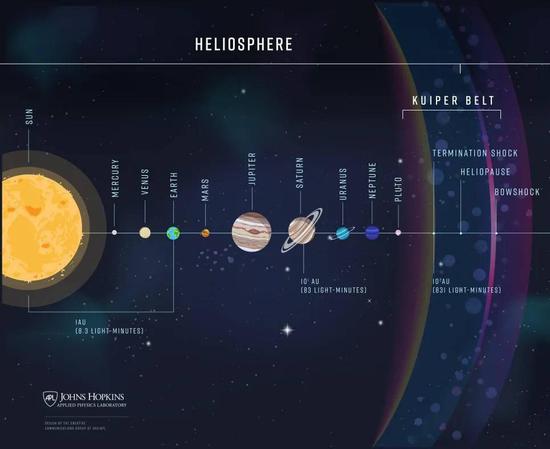在星际介质中穿行的旅行者1号探测器听到了一种神秘的嗡嗡声,就如同有人在那里“低吟浅唱……正当全世界的目光聚集在火星身上,在更加遥远——遥远得多——的地方,最早的太空探测器之一以及距离地球最遥远的人造天体旅行者1号探测器在遥远的深空又有了新发现。

Voyager spacecraft detects 'persistent hum' beyond our solar system
One of the Earth's longest-flying spacecraft has detected a "persistent hum" beyond our solar system, according to a new study.
一项新的研究表明,地球上飞行时间最长的航天器之一,在我们的太阳系之外发现了“持续的嗡嗡声”。
NASA's Voyager 1 launched on September 5 1977, from Cape Canaveral, Florida, aboard a Titan-Centaur rocket, just weeks after its sister craft, Voyager 2. Although they were initially designed to last five years, more than 43 years after they launched, the crafts are still sending back data as they explore interstellar space.
美国宇航局的旅行者1号于1977年9月5日从美国佛罗里达州卡纳维拉尔角搭乘Titan-Centaur火箭发射升空,距它的姊妹飞行器旅行者2号发射升空仅数周。尽管它们最初的设计寿命仅为五年,但在发射后的43年时间里,这两台探测器仍然在持续探索星际空间的同时向地球发回数据。

Instruments aboard Voyager 1, which has moved past the edge of the solar system, through the solar system's border with interstellar space, known as the heliopause, and into the interstellar medium, have detected the sounds of plasma waves, according to research published Monday in the journal Nature Astronomy.
周一美国《自然天文学》杂志发表了一篇文章,目前已经越过太阳系边缘,穿过太阳系与星际空间的边界(也被称为日球顶层),并进入星际介质的旅行者1号,探测到了等离子波的声音。
A Cornell University-led team studied data transmitted from the spacecraft, sent from 14 billion miles away and discovered the interstellar gas emissions. "It's very faint and monotone, because it is in a narrow frequency bandwidth," Stella Koch Ocker, a Cornell University doctoral student in astronomy, said in a statement. "We're detecting the faint, persistent hum of interstellar gas."
由康奈尔大学领导的团队对140亿英里之外的旅行者1号航天器传回的数据进行了研究,发现了星际气体放射的声音。康奈尔大学天文学博士生斯特拉·科赫·奥克特(Stella Koch Ocker)在一份声明中说:“这是非常微弱和单调的,因为它它处于一个狭窄的频率带宽。” “我们正在探测星际物质的微弱、持续的嗡嗡声。”

NASA's Voyager 1 spacecraft flew by Jupiter in 1979, and by Saturn in 1980, before crossing the heliopause in August 2012.
NASA的旅行者1号航天器于1979年飞越了木星,1980年飞越了土星,2012年8月,它飞过了太阳系边缘,进入了星际空间。
"The interstellar medium is like a quiet or gentle rain," James Cordes, the George Feldstein Professor of Astronomy at Cornell and senior author of the study, said in a statement. "In the case of a solar outburst, it's like detecting a lightning burst in a thunderstorm and then it's back to a gentle rain."
康奈尔大学的天文学教授乔治·费尔德斯坦,该研究的高级研究员詹姆斯·科德斯说:“星际介质就像是安静而轻柔的雨。在太阳爆发的情况下,这就像检测到雷暴中的闪电爆炸,然后又回到了柔和的雨中。”
Researchers think there is more low-level activity in the interstellar gas than was previously believed. This will allow researchers to monitor the spatial distribution of plasma. Voyager 1's data can also help scientists understand the interactions between the interstellar medium and the sun's solar wind, a steady stream of charged particles outflowing from our star.
研究小组认为,那场微雨表明星际介质中的低空活动可能比科学家们想象的要多。这有助于研究人员监测等离子体的空间分布。旅行者1号传回的数据还可以帮助科学家了解星际介质与太阳风(从恒星流出的稳定的带电粒子流)之间的相互作用。
"We've never had a chance to evaluate it. Now we know we don't need a fortuitous event related to the sun to measure interstellar plasma," Cornell research scientist Shami Chatterjee added.
康奈尔大学的天文学家莎米·查特吉说:“我们从来没有机会对其进行评估。现在,我们知道我们不需要与太阳有关的偶然事件来测量星际等离子体。”